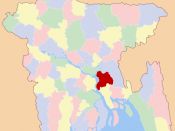Discussion Paper Set #6:
Chandpur Irrigation Project
When looking at the repercussions of the Chandpur Irrigation Project (CIP) it is important to look at how the CIP project affected class structure and gender, realizing the benefits of the project were not shared equally by all residents. It is therefore hard to say if the project "improved" the living conditions for the residents considering there was such a strong degree of contradictions and varying affects for all the people.
The construction of the CIP project created many social and economic changes that influenced people both within and outside of the area. One change that did occur is that residents within the CIP area were able to eat better, although the increase in food supply was proportional to class status and family structure. Although families were able to eat better food crops could not be grown along side or intercropped with the paddy because of the flood irrigation.
This forced women who had garden space to grow needed food crops in their garden increasing their work load with the icrease in post harvest labour. Women who were landless were forced to buy all their needed food crops from women outside the Chandpur Irrigation district. Because of the irrigation project families inside the district spent ten times as much on food compared to those that lived outside the district. Women outside the district were able to increase their wage earnings by growing vegetable crops that many families within the district needed to buy to supplement their own production. Most importantly there was an overall increase in the food costs for families within the district because they were more limited in 't they could grow themselves. Food prices for families within the chandpur district increased by 10% which offsets the overall increase in...


